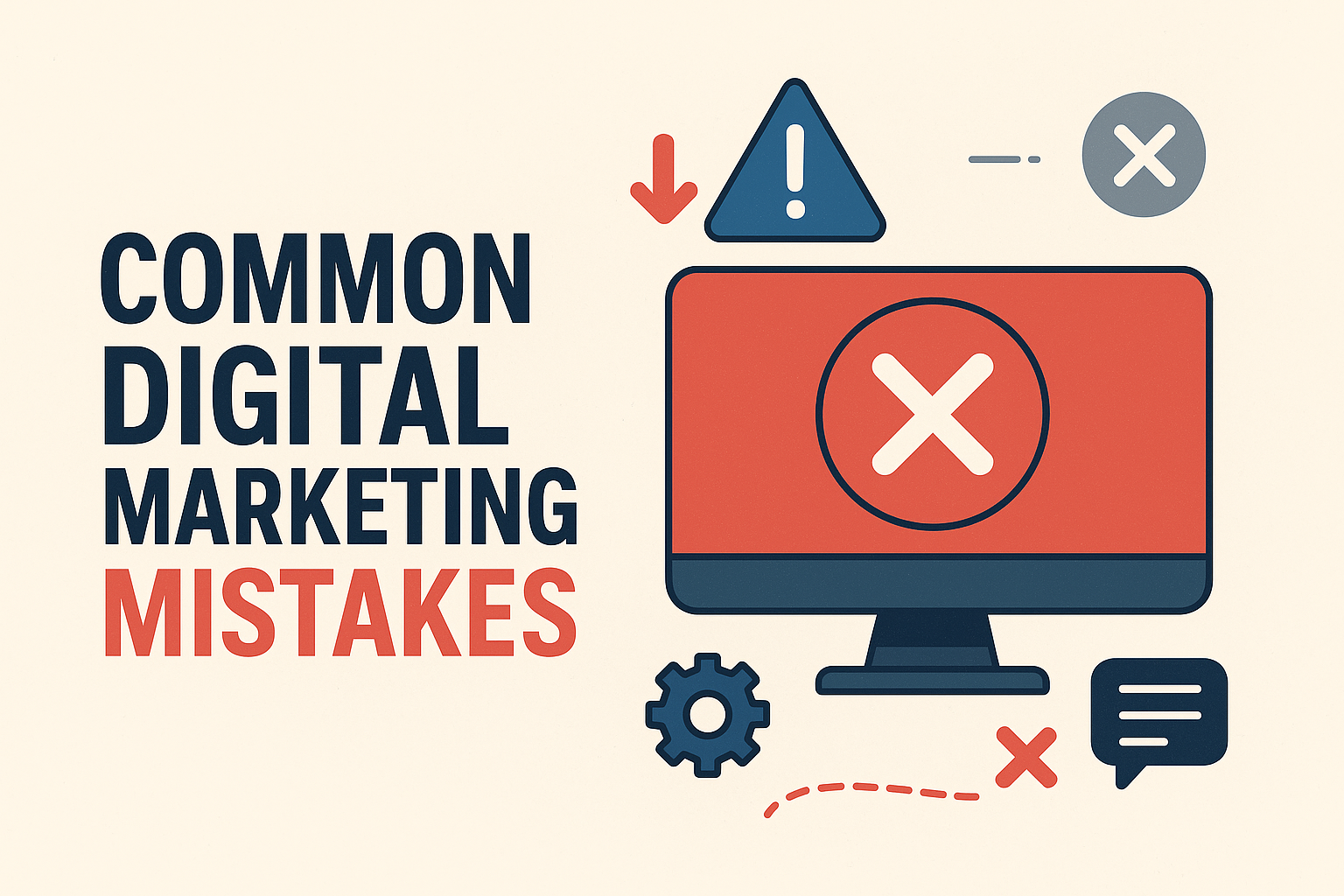Digital marketing plays a critical role in helping businesses reach their audience and achieve growth.
However, even small mistakes in strategy or execution can lead to wasted budgets, poor results, and missed opportunities.
Many businesses dive into digital marketing without fully understanding the common pitfalls, resulting in campaigns that fail to deliver.
By identifying these mistakes and knowing how to avoid them, you can create effective strategies that drive real results and sustainable growth.
Top 10 Digital Marketing Mistakes and How to Avoid Them
Explore the frequent digital marketing errors companies face and find effective strategies to prevent them.
Improve your campaigns and achieve better results with these expert tips.
1. Ignoring the Target Audience
Failing to focus on the right audience is one of the most critical errors in digital marketing.
Businesses often assume that everyone will be interested in their product, which is never true.
When you don’t define your audience, your campaigns reach the wrong people, wasting both money and time.
Before launching any ad or creating content, you must know who you are targeting: their age, location, interests, and the problems they want to solve.
This understanding helps you create the right message for the right people.
For example, if you are selling fitness equipment, your audience could be health-conscious people between 18 and 40 years old.
The better you understand your audience, the more effective your marketing becomes, leading to higher engagement and better results.
Skipping this step is like talking to a crowd without knowing what they care about.
How to Avoid This:
Create a buyer persona with details like age, gender, location, and interests.
Use analytics tools and surveys to understand your audience better before running campaigns.

2. No Clear Goal
Running marketing campaigns without a clear goal is another common mistake. If you don’t know what you want to achieve, you cannot measure success.
A campaign without an objective is like driving without knowing the destination.
You will waste fuel and time and still not reach anywhere. Before starting, ask yourself: Do you want more website visitors, more leads, or direct sales?
Defining clear, measurable objectives provides focus and simplifies progress tracking.
For example, instead of saying “I want more traffic,” aim for “Increase website traffic by 20% in 3 months.”
This clarity helps you choose the right strategies and allocate the right budget.
Without a goal, you will keep spending money without knowing what worked or what failed. Always start with a purpose so you can create a focused plan and achieve better results.
How to Avoid This:
Set SMART goals (Specific, Measurable, Achievable, Relevant, Time-bound) for every campaign and track progress regularly.
3. Neglecting SEO
Search Engine Optimization (SEO) is often ignored because businesses expect instant results from paid ads.
While ads can bring quick traffic, SEO provides long-term benefits that paid campaigns cannot match.
If your website is not optimized for search engines, you are missing out on free, organic traffic that could bring consistent leads and customers.
SEO includes improving site speed, using the right keywords, writing quality content, and earning backlinks.
Ignoring these elements means your competitors will outrank you, and you will always rely on ads.
Over time, this increases your marketing cost. SEO may take time, but once your site ranks well, you will get traffic without paying for every click.
Treat SEO as an investment rather than an option. Businesses that combine paid ads with strong SEO see better long-term results and higher profitability.
How to Avoid This:
Work on keyword research, on-page optimization, and quality content. Use free tools like Google Search Console to monitor SEO performance.

4. Not Tracking Results
Another major mistake is running campaigns without tracking results. Many businesses spend money on ads without checking what works and what doesn’t.
This leads to wasted budget and missed opportunities for improvement.
Every campaign should be monitored using analytics tools like Google Analytics, Google Tag Manager, or Meta Ads Manager.
Tracking helps you understand which channels drive traffic, which keywords perform well, and which ads convert the most.
Without this data, you are guessing instead of making informed decisions.
Monitoring helps identify areas to reduce expenses and spots where additional investment is worthwhile.
For example, if one ad set is performing better, you can increase its budget while stopping the weak ones.
Marketing without tracking is like playing a game blindfolded. Always analyze and optimize your campaigns based on real numbers.
How to Avoid This:
Always connect your campaigns with analytics tools and review performance reports regularly to optimize your strategy.
5. Overlooking Mobile Users
Most people use mobile devices to browse websites and social media, yet many businesses still ignore mobile optimization.
A site that looks great on a desktop but loads slowly or breaks on a phone will push customers away.
Mobile users expect fast-loading pages and easy navigation. If your site takes too long to load or is hard to use, visitors will leave and never come back.
Google also ranks mobile-friendly sites higher in search results, so ignoring mobile optimization hurts your SEO as well.
Test your website on different devices and screen sizes. Make sure images are optimized, buttons are easy to click, and the design adjusts to all screens.
Mobile-friendly websites improve user experience and increase conversions. Businesses that overlook this factor lose a big share of potential customers.
How to Avoid This:
Use a responsive design, compress images, and run Google’s Mobile-Friendly Test to ensure your site works well on all devices.

6. Posting Without Strategy
Sharing content on social media without a defined plan can harm your brand’s strength.
Many businesses post only when they feel like it or share content that has no purpose. This approach fails to engage the audience or deliver results.
A good strategy includes planning content ahead, using a calendar, and creating posts that align with your business goals.
Each post should have a reason, whether it is to inform, educate, or promote.
Consistency is also important because irregular posting makes your audience forget your brand.
Analyze which type of content performs well, and use insights to improve future posts.
A strong content strategy saves time, improves engagement, and builds a loyal audience.
Random posting, on the other hand, makes your marketing efforts look unprofessional and ineffective.
How to Avoid This:
Create a monthly content calendar, plan posts in advance, and ensure every post supports your business goals.
7. Ignoring Email Marketing
Email marketing remains one of the most effective ways to reach customers, yet many businesses ignore it.
Social media platforms can change algorithms anytime, reducing your reach. Email, however, provides a direct line to your audience.
A strong email list helps you build relationships and share valuable information without depending on paid ads.
Ignoring email marketing means missing out on a high-ROI channel.
Start by collecting emails from your website visitors, offering useful resources in exchange for sign-ups.
Send newsletters, updates, and exclusive offers that provide real value. Keep your emails short, clear, and relevant. Personalization can also make emails more engaging.
Businesses that invest in email marketing build stronger customer connections and see better long-term results compared to those relying only on social media or ads.
How to Avoid This:
Build an email list, segment it based on user interests, and send regular, valuable content to keep your audience engaged.

8. Using the Same Content Everywhere
Posting identical content on every platform is a common mistake that lowers engagement.
Each platform has its own style, audience, and content format.
For instance, Instagram prioritizes visuals, LinkedIn favors professional insights, and Twitter thrives on quick updates.
Posting the same thing everywhere makes your content look repetitive and irrelevant.
Instead, customize your content for each platform while keeping the core message consistent.
Use platform-specific features like Instagram Stories, LinkedIn Articles, or Facebook Reels to maximize reach.
This approach requires more effort but creates better engagement and brand visibility.
Repeating the same post across channels not only bores your audience but also signals a lack of creativity.
Businesses that adapt their content for each platform stand out and connect better with users.
How to Avoid This:
Create platform-specific versions of your content and adapt your message to suit the audience and format of each channel.
9. Not Testing Ads
Running a single version of an ad and expecting great results is unrealistic. Many businesses make this mistake and waste money on underperforming campaigns.
Experimentation is key to discovering what performs best. A/B testing allows you to compare variations of headlines, images, ad text, and call-to-action buttons.
Even small changes can significantly improve performance. For example, a new headline might increase clicks, or a different image might attract more attention.
Without testing, you are relying on guesswork. Always create multiple versions of an ad and monitor which one performs better.
Shift your budget to the winning ad and stop the weak ones. Regular testing helps you optimize campaigns for higher conversions and lower costs.
Ignoring this step means losing money and missing opportunities for improvement.
How to Avoid This:
Always create multiple ad variations and run A/B tests to identify the best-performing elements.

10. Forgetting Customer Engagement
Digital marketing is not just about posting content or running ads; it is about building relationships.
Many businesses forget this and focus only on selling. Customers want interaction and quick responses to their questions.
Ignoring comments, messages, or reviews creates a negative impression and drives customers away.
Engaging with your audience shows that you care about them. Reply to comments, answer questions, and thank customers for feedback.
This small effort builds trust and loyalty over time. Include polls, questions, and other interactive elements to drive engagement.
The more engaged your audience is, the stronger your brand becomes. Businesses that fail to engage miss the chance to turn followers into loyal customers.
Always remember, marketing is a two-way communication, not a one-way broadcast.
How to Avoid This:
Respond to comments and messages promptly, and use interactive content like polls and Q&A to keep your audience engaged.
How Can Brandout Help You Avoid These Mistakes?
Brandout creates digital marketing strategies that avoid common errors and ensure trackable results.
From SEO optimization and paid ad management to content planning and analytics tracking, we ensure every effort aligns with your goals.
Our team focuses on smart execution so you get the maximum ROI without wasting resources.
Conclusion:
Digital marketing mistakes can drain time and resources, leading to missed opportunities and reduced ROI, but with the right strategies, these errors are completely preventable.
By understanding these pitfalls and implementing the right strategies, you can build campaigns that perform effectively and sustainably.
Stay consistent, track results, and keep learning to maintain a strong online presence in an ever-changing digital world.
Most Asked Questions:
Why is SEO important in digital marketing?
SEO helps websites rank higher on search engines, bringing free and consistent traffic. Ignoring SEO means relying only on paid ads, which increases long-term marketing costs.
Why is mobile optimization important in digital marketing?
Most users access websites from mobile devices. A mobile-friendly site improves user experience, reduces bounce rates, and boosts SEO rankings.
What is the role of A/B testing in digital marketing?
A/B testing compares different versions of ads or content to see which performs better. It helps improve conversion rates and reduces wasted ad spend.
How does content strategy affect digital marketing success?
A solid content strategy ensures consistent posting, relevant topics, and better engagement. Random posting without a plan often fails to attract the right audience.
What happens if I don’t track my campaign results?
Not tracking results means you can’t identify what’s working and what’s wasting money. Analytics help optimize campaigns and improve return on investment.
Why is customer engagement important in digital marketing?
Engaging with customers builds trust and loyalty. Responding to comments, messages, and reviews shows you value your audience and strengthens your brand reputation.




